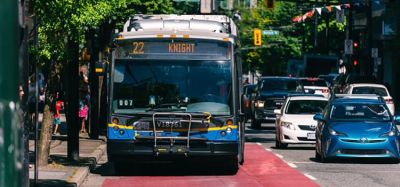Ticketing and mobility: The legal challenges
- Like
- Digg
- Del
- Tumblr
- VKontakte
- Buffer
- Love This
- Odnoklassniki
- Meneame
- Blogger
- Amazon
- Yahoo Mail
- Gmail
- AOL
- Newsvine
- HackerNews
- Evernote
- MySpace
- Mail.ru
- Viadeo
- Line
- Comments
- Yummly
- SMS
- Viber
- Telegram
- Subscribe
- Skype
- Facebook Messenger
- Kakao
- LiveJournal
- Yammer
- Edgar
- Fintel
- Mix
- Instapaper
- Copy Link
Posted: 19 August 2021 | Ed Barratt, Jeremy Godley | No comments yet
In an interview with Intelligent Transport, Osborne Clarke’s Jeremy Godley and Edward Barratt discuss the legal challenges around ticketing and mobility.


What elements do you think make ticketing so complex for both operators and passengers?
The regulatory structure of ticketing in the UK has been one of the biggest drivers of complexity”
Jeremy Godley (JG): The regulatory structure of ticketing in the UK has been one of the biggest drivers of complexity, as this structure sees passengers dealing with split ticketing. Here’s the scenario: a football fan in Newcastle who is going to see his team play against Southampton ends up with 30 different paper tickets and is constantly switching trains and switching seats. Why? Because each of those individual tickets, as a whole, are cheaper than just buying one return from Point A to Point B. Tackling this decreases complexity in two ways: for passengers and also for operators.
The UK government has now committed to simplifying train fares and ticketing in the Williams-Shapps Plan for Rail, and that promises some fundamental changes.
In terms of regulation, do you think that we need more or less central government involvement? Is it necessary for the delivery of simplified, interoperable ticketing solutions?
JG: We were involved in the MyCorridor project, which is one of three European Union (EU) funded Mobility-as-a-Service (MaaS) research projects. One thing that we quickly realised for our project, which is specifically about cross-border MaaS, is: how do you get successful MaaS applications to talk to each other, to interact with each other? It’s not just about plugging in the transport operators with the users, it’s about linking up the different platforms. And that can present some significant challenges!
One aspect will be avoiding built-in obsolescence and preserving the ability to take advantage, to the greatest extent, of flexibility and the potential for developments in technology”
Edward Barratt (EB): With the complexity of some of these problems, it’s tempting to think of a unified solution. But, actually, I believe that we will see more of a patchwork approach in terms of getting different elements of the solution right. One aspect will be avoiding built-in obsolescence and preserving the ability to take advantage, to the greatest extent, of flexibility and the potential for developments in technology. Using cloud-based solutions may enable a more effective interface with legacy systems. Building systems which are accessible and scalable is likely to be important, too.
JG: Part of this is about making sure that you end up with a contract that is flexible enough to build in new ideas. This is something where we, as lawyers, try to offer solutions. It may be that the market evolves to provide interoperable solutions, or it may be that some legislative intervention is required to ensure that the various platforms all speak to each other and are, therefore, able to share data and commit to joint transport and journey planning.
Where do you think the industry is in terms of placing passenger accessibility at the heart of what they do?
EB: It’s crucial, and it’s something that the UK government has recognised in its recent announcements around its rail and bus strategy. We have a tendency to refer to the customer or the passenger as if every person has the same needs. Mass transit is still the most efficient way to move large numbers of people around, but it’s clear that everyone’s mobility needs are different, though, and that everybody engages differently.
In an ideal world, a MaaS application will be able to not just tell you train times and enable journey planning, but it will also be able to build that narrative completely around the individual”
JG: In an ideal world, a MaaS application will be able to not just tell you train times and enable journey planning, but it will also be able to build that narrative completely around the individual. It will be able to provide a route that gives you what you need, whether you’re a tourist or a commuter, or if you have accessibility needs. It’s a question of perfecting how we use data and then being able to communicate that in a meaningful way through the user interface to the passenger.
EB: Better use of data and artificial intelligence (AI) has the potential to support more tailored solutions, and identifying how participants in a mobility solution can share and use data compliantly is something that we are often asked to advise on. It goes to trust and it goes to brand.
Making a wider range of mobility solutions more attractive and accessible is also a fundamental part of making travel greener. Ensuring that everyone has access to better mobility options is a core part of the response to the climate change challenge.
What innovations are you seeing in transport planning post-COVID-19?
JG: Something that we’ve seen, which I think is really interesting within the suburban mobility framework, is that some of our property developer clients who are looking at purchasing sites and constructing new residential developments are thinking, “Where does transport fit in?”
There’s an attempt by developers to move away from basement car parks now and to think that, actually, their location – such as an apartment block – is itself a mobility hub. They are beginning to look at, for example, putting a small fleet of electric vehicles in the basement instead and giving residents access to an exclusive app that allows them to hire or access those vehicles, or are looking to facilitate the use of e-scooters and e-bikes in the surrounding areas. That move, I think, is really interesting.
Encouraging people to look at more flexible, sustainable mobility solutions post-COVID-19 is a key focus area”
Another trend is dynamic bus routes based on the demand of the users of an app. You can easily see residential locations essentially becoming permanent bus stops in that type of ecosystem.
EB: We’ve seen local authorities saying, “What can we do that’s more creative?”. Whether it’s electric vehicles, whether it’s demand-responsive transport (DRT), the scope is there. Encouraging people to look at more flexible, sustainable mobility solutions post-COVID-19 is a key focus area for public authorities, providers and investors.




Related topics
Accessibility, Artificial Intelligence, COVID-19, Journey Planning, Mobility Services, On-Demand Transport, Passenger Accessibility, Passenger Experience, Public Transport, Ticketing & Payments, Transport Governance & Policy, Travel & Passenger Information
Related cities
United Kingdom
Related organisations
European Union (EU), Osborne Clarke
Related people
Edward Barratt, Jeremy Godley








